Which of the following levels of ecological organization is arranged
in the correct sequence from most to least inclusive?
A)
community, ecosystem, individual, population
B) ecosystem,
community, population, individual
C) population, ecosystem,
individual, community
D) individual, population, community,
ecosystem
E) individual, community, population, ecosystem
Answer: B
Palm trees and subtropical plants are commonplace in Land's End,
England, whose latitude is the equivalent of Labrador in coastal
Canada where the local flora is subarctic. Which statement best
explains why this apparent anomaly exists between North America and
Europe?
A) Labrador does not get enough rainfall to support the
subtropical flora found in Land's End.
B) Warm ocean currents
interact with England, whereas cold ocean currents interact with
Labrador.
C) Rainfall fluctuates greatly in England; rainfall is
consistently high in Labrador.
D) Labrador is too windy to
support tall plants, such as palm trees.
E) Labrador receives
sunlight of lower duration and intensity than does Land's End.
Answer: B
The main reason polar regions are cooler than the equator is that
A) there is more ice at the poles.
B) sunlight strikes the
poles at a lower angle.
C) the poles are farther from the sun.
D) the polar atmosphere is thinner and contains fewer greenhouse
gases.
E) the poles are permanently tilted away from the sun.
Answer: B
Which of the following environmental features might influence
microclimates?
A) forest canopy
B) freshly plowed field
C) log on the forest floor
D) large boulder
E) All
of the options are correct.
Answer: E
Which of the following are important biotic factors that can affect
the structure and organization of biological communities?
A)
precipitation, wind
B) nutrient availability, soil pH
C)
predation, competition
D) temperature, water
E) light
intensity, seasonality
Answer: C
The growing season would generally be shortest in which of the
following biomes?
A) savanna
B) temperate broadleaf forest
C) temperate grassland
D) tropical rain forest
E)
coniferous forest
Answer: E
A population is correctly defined as having which of the following characteristics?
I. inhabiting the same general area
II. belonging to the same species
III. possessing a
constant and uniform density and dispersion
A) I only
B) III only
C) I and
II only
D) II and III only
E) I, II, and III
Answer: C
An ecologist recorded 12 white-tailed deer, Odocoileus virginianus,
per square mile in one woodlot and 20 per square mile in another
woodlot. What was the ecologist comparing?
A) density
B)
dispersion
C) carrying capacity
D) cohorts
E) range
Answer: A
Which of the following groups would be most likely to exhibit uniform
dispersion?
A) red squirrels, who actively defend territories
B) cattails, which grow primarily at edges of lakes and streams
C) dwarf mistletoes, which parasitize particular species of
forest tree
D) moths, in a city at night
E) lake trout,
which seek out cold, deep water high in dissolved oxygen
Answer: A
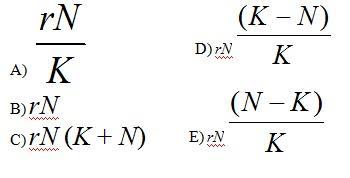
Exponential growth of a population is represented by dN/dt =
A. SEE IMAGE
B. SEE IMAGE
C. SEE
IMAGE
D. SEE IMAGE
E. SEE IMAGE
Answer: B

Logistic growth of a population is represented by dN/dt =
A. SEE IMAGE
B. SEE IMAGE
C. SEE
IMAGE
D. SEE IMAGE
E. SEE IMAGE
Answer: D
Carrying capacity is
A) seldom reached by marine producers and
consumers because of the vast resources of the ocean.
B) the
maximum population size that a particular environment can support.
C) fixed for most species over most of their range most of the
time.
D) determined by density and dispersion data.
E) the
term used to describe the stress a population undergoes due to limited resources.
Answer: B
Which of the following is characteristic of K-selected populations?
A) offspring with good chances of survival
B) many
offspring per reproductive episode
C) small offspring
D) a
high intrinsic rate of increase
E) early parental reproduction
Answer: A
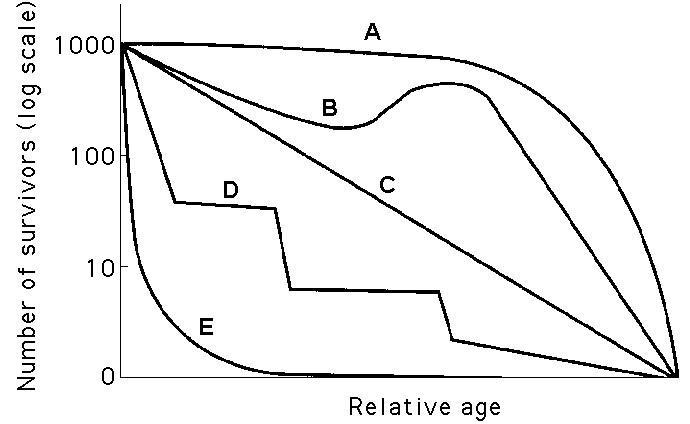
Which curve best describes survivorship in marine molluscs?
A)
A
B) B
C) C
D) D
E) E
Answer: E
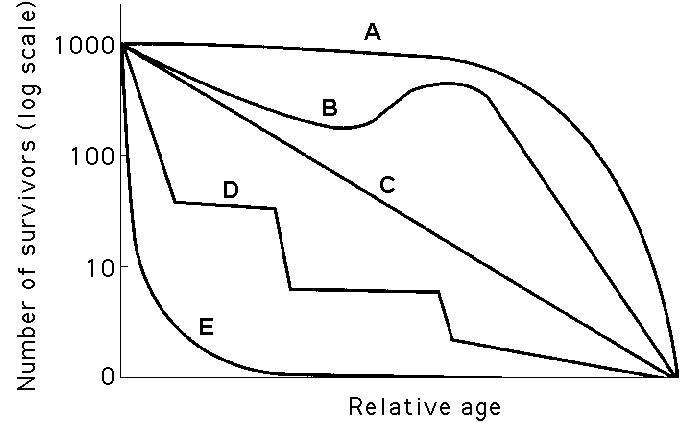
Which curve best describes survivorship in a marine crustacean that
molts?
A) A
B) B
C) C
D) D
E) E
Answer: D
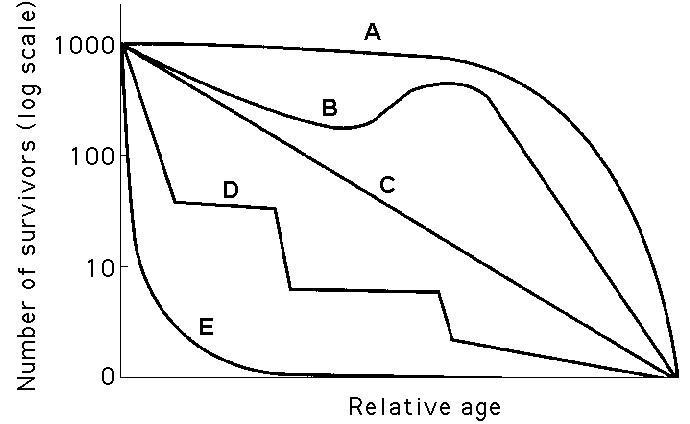
Which curve best describes survivorship in humans who live in
developed nations?
A) A
B) B
C) C
D) D
E) E
Answer: A

Which population(s) is (are) in the process of decreasing?
A) I
B) II
C) III
D) I and II
E) II and III
Answer: B

Which population(s) appear(s) to be stable?
A) I
B) II
C) III
D) I and II
E) II and III
Answer: C

Assuming these age-structure diagrams describe human populations, in
which population is unemployment likely to be a societal issue in the
future?
A) I
B) II
C) III
D) No differences in
the magnitude of future unemployment would be expected among these
populations.
E) It is not possible to infer anything about
future social conditions from age-structure diagrams.
Answer: A

Assuming these age-structure diagrams describe human populations,
which population(s) is (are) likely to experience zero population
growth (ZPG)?
A) I
B) II
C) III
D) I and II
E) II and III
Answer: C
A population's carrying capacity
A) may change as environmental
conditions change.
B) can be accurately calculated using the
logistic growth model.
C) generally remains constant over time.
D) increases as the per capita growth rate (r) decreases.
E) can never be exceeded.
Answer: A

According to the logistic growth equation
SEE IMAGE
A) the number of individuals added per unit time is greatest when N
is close to zero.
B) the per capita growth rate (r) increases as
N approaches K.
C) population growth is zero when N equals K.
D) the population grows exponentially when K is small.
E)
the birth rate (b) approaches zero as N approaches K.
Answer: C
During exponential growth, a population always
A) grows by
thousands of individuals.
B) grows at its maximum per capita
rate.
C) quickly reaches its carrying capacity.
D) cycles
through time.
E) loses some individuals to emigration.
Answer: B
Which of the following statements about human population in
industrialized countries is incorrect?
A) Life
history is r-selected.
B) Average family size is relatively
small.
C) The population has undergone the demographic
transition.
D) The survivorship curve is Type I.
E) Age
distribution is relatively uniform.
Answer: A
According to the competitive exclusion principle, two species cannot
continue to occupy the same
A) habitat.
B) niche.
C)
territory.
D) range.
E) biome.
Answer: B
Which of the following is an example of Batesian mimicry?
A) an
insect that resembles a twig
B) a butterfly that resembles a
leaf
C) a nonvenomous snake that looks like a venomous snake
D) a fawn with fur coloring that camouflages it in the forest
environment
E) a snapping turtle that uses its tongue to mimic a
worm, thus attracting fish
Answer: C
Which of the following is an example of aposematic coloration?
A) stripes of a skunk
B) eye color in humans
C)
green color of a plant
D) colors of an insect-pollinated flower
E) a katydid whose wings look like a dead leaf
Answer: A
Dwarf mistletoes are flowering plants that grow on certain forest
trees. They obtain nutrients and water from the vascular tissues of
the trees. The trees derive no known benefits from the dwarf
mistletoes. Which of the following best describes the interactions
between dwarf mistletoes and trees?
A) mutualism
B)
parasitism
C) commensalism
D) facilitation
E) competition
Answer: B
Evidence shows that some grasses benefit from being grazed. Which of
the following terms would best describe this plant-herbivore
interaction?
A) mutualism
B) commensalism
C)
parasitism
D) competition
E) predation
Answer: A
Which of the following terms is used by ecologists to describe the
community interaction where one organism makes the environment more
suitable for another organism?
A) parasitism
B) mutualism
C) inhibition
D) facilitation
E) commensalism
Answer: D
In a tide pool, 15 species of invertebrates were reduced to eight
after one species was removed. The species removed was likely a(n)
A) pathogen.
B) keystone species.
C) herbivore.
D) resource partitioner.
E) mutualistic organism.
Answer: B
Which of the following is the most accepted hypothesis as to why
invasive species take over communities into which they have been
introduced?
A) Invasive species are more aggressive than native
species in competing for the limited resources of the environment.
B) Invasive species are not held in check by the predators and
agents of disease that have always been in place for the native
species.
C) Humans carefully select which species will
outcompete nuisance native species.
D) Invasive species have a
higher reproductive potential than native species.
E) Invasive
species come from geographically isolated regions, so when they are
introduced to regions where there is more competition, they thrive.
Answer: B
During the course of the formation of a parasite/host relationship, a
critical first step in this evolution would be
A) changing the
behavior of the host or intermediate host.
B) developing asexual
reproduction.
C) deriving nourishment without killing the host.
D) starting as an ectoparasite and then later becoming an
endoparasite.
E) utilizing heterotropic nutrition during
infection and autotrophic nutrition during dormancy.
Answer: C
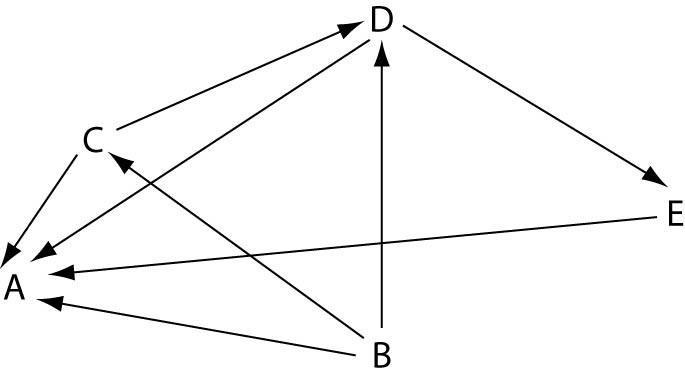
Which letter represents an organism that could be a
carnivore?
A) A
B) B
C) C
D)
D
E) E
Answer: E
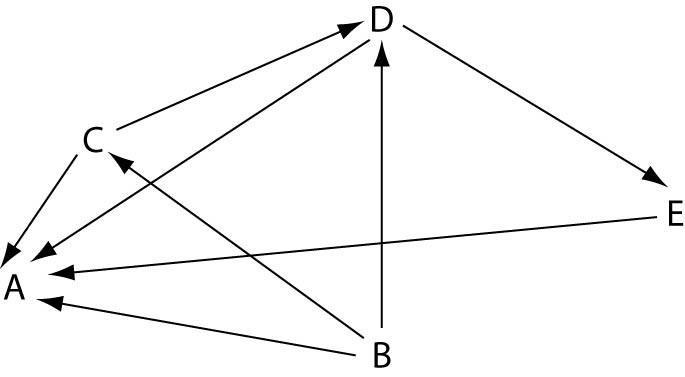
Which letter represents an organism that could be a primary
consumer?
A) A
B) B
C) C
D) D
E) E
Answer: C
The principle of competitive exclusion states that
A) two
species cannot coexist in the same habitat.
B) competition
between two species always causes extinction or emigration of one
species.
C) competition in a population promotes survival of the
best-adapted individuals.
D) two species that have exactly the
same niche cannot coexist in a community.
E) two species will
stop reproducing until one species leaves the habitat.
Answer: D
Ecology as a discipline directly deals with all of the following levels of biological organization except
A) cellular
B) organismal
C) population
D) ecosystem
E) community
Answer: A
Which statement best contrasts environmentalism with ecology?
A) Ecologists study organisms in environments that have been undisturbed by human activities; environmentalists study the effects of human activities on organisms.
B) Ecology is the study of the environment; environmentalism is the study of ecology.
C) Ecology provides scientific understanding of current living things and their environment; environmentalism is mainly about conservation and preservation of life on Earth.
D) Environmentalists are only involved in politics and advocating for protecting nature; ecologists are only involved in scientific investigations of the environment.
E) Environmentalism is devoted to applied ecological science; ecology is concerned with basic/theoretical ecological science.
Answer: C
Where would an ecologist find the most phytoplankton in a lake?
A) profundal zone
B) oligotrophic zone
C) photic zone
D) benthic zone
E) aphotic zone
Answer: C
The most important factor affecting the distribution of biomes is
A) wind and ocean water current patters
B) proximity to large bodies of water
C) day length and rainfall
D) species diversity
E) climate
Answer: E
An area which different terrestrial biomes grade into each other is known as a
A) abyssal zone
B) littoral zone
C) cline
D) vertically stratified canopy
E) ecotone
Answer: E
Tropical grasslands with scattered trees are also known as
A) chaparrals
B) temperate plains
C) tundras
D) taigas
E) savannas
Answer: E
which type of biome would most likely occur in a climate with mild, rainy winters and hot, dry summers with an ofter fires?
A) desert
B) savanna
C) chaparral
D) taiga
E) temperate grassland
Answer: C
Which of the following is a prime cause of Earth's seasons?
A) global wind patterns
B) the tilt of Earths axis
C) changes in Earth's distance from the sun
D) global air circulation
E) ocean currents
Answer: B
A table listing such items as age, observed number of organisms alive each year, and life expectancy is known as a
A) rate table
B) survivorship table
C) mortality table
D) life table
E) insurance table
Answer: B
You are observing a population of lizards when you notice that the number of adults has increased and is higher than previously very recently observed. One explanation for such an observation would include
A) reduction in death rate.
B) increased immigration.
C) decreased emigration.
D) increased birth rate.
E) increased emigration.
Answer: B
Demography is the study of
A) life expectancy of individuals within a population.
B) the vital statistics of populations and how they change over time.
C) reproductive rates of a population during a given year.
D) death and emigration rates of a population at any moment in time.
E) the survival patterns of a population.
Answer: D
Which of the following is the pattern of spacing for individuals within the boundaries of the population?
A) cohort
B) dispersion
C) iteroparous
D) semelparous
E) Allee effect
Answer: B
A species of fish is found to require a certain water temperature, a particular oxygen content of the water, a particular depth, a rocky substrate on the bottom, and a variety of nutrients in the form of microscopic plants and animals to thrive. These requirements describe its
A) ecological niche.
B) home base.
C) resource partition.
D) prime habitat.
E) dimensional profile.
Answer: A
Which of the following types of species interaction is correctly paired with its effects on the density of the two interacting populations?
A) mutualism: both decrease
B) predation: as one increases, the other increases
C) competition: both increase
D) parasitism: both decrease
E) commensalism: as one increases the other stays the same
Answer: E
The species richness of a community refers to the
A) complexity of the food web.
B) total number of all organisms.
C) the bottom-heavy shape of the energy pyramid.
D) relative numbers of individuals in each species.
E) number of different species.
Answer: E
The dominant species in a community is
A) the best competitor in the community.
B) the best predator in the community.
C) the species that contributes the most biomass to the community.
D) characterized by very large individuals with long lives.
E) the most energetically efficient species in the community.
Answer: A
Which of the following describes the relationship between ants and acacia trees?
A) inhibition
B) commensalism
C) mutualism
D) parasitism
E) facilitation
Answer: C
If global warming continues at its present rate, which biomes will likely take the place of the coniferous forest (taiga)?
A) temperate broadleaf forest and grassland
B) desert and chaparral
C) tundra and polar ice
D) tropical forest and savanna
E) chaparral and temperate broadleaf forest
Answer: A
Which marine zone would have the lowest rates of primary productivity (photosynthesis)?
A) abyssal
B) neritic
C) intertidal
D) continental shelf
E) pelagic
Answer: A
If a meteor impact or volcanic eruption injected a lot of dust into the atmosphere and reduced the sunlight reaching Earth's surface by 70% for one year, all of the following marine communities most likely would be greatly affected except
A) coral reef communities.
B) estuary communities.
C) pelagic communities.
D) benthic communities.
E) deep-sea vent communities.
Answer: E